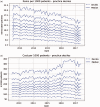Trends and variation in prescribing of low-priority treatments identified by NHS England: a cross-sectional study and interactive data tool in English primary care
- PMID: 29787684
- PMCID: PMC6022888
- DOI: 10.1177/0141076818769408
Trends and variation in prescribing of low-priority treatments identified by NHS England: a cross-sectional study and interactive data tool in English primary care
Abstract
Objectives NHS England recently announced a consultation seeking to discourage the use of treatments it considers to be low-value. We set out to produce an interactive data resource to show savings in each NHS general practice and to assess the current use of these treatments, their change in use over time, and the extent and reasons for variation in such prescribing. Design Cross-sectional analysis. Setting English primary care. Participants English general practices. Main outcome measures We determined the cost per 1000 patients for prescribing of each of 18 treatments identified by NHS England for each month from July 2012 to June 2017, and also aggregated over the most recent year to assess total cost and variation among practices. We used mixed effects linear regression to determine factors associated with cost of prescribing. Results Spend on low-value treatments was £153.5 m in the last year, across 5.8 m prescriptions (mean, £26 per prescription). Among individual treatments, liothyronine had the highest prescribing cost at £29.6 m, followed by trimipramine (£20.2 m). Over time, the overall total number of low-value prescriptions decreased, but the cost increased, although this varied greatly between treatments. Three treatment areas increased in cost and two increased in volume, all others reduced in cost and volume. Annual practice level spending varied widely (median, £2262 per thousand patients; interquartile range £1439 to £3298). Proportion of patients over 65 was strongly associated with low-value prescribing, as was Clinical Commissioning Group. Our interactive data tool was deployed to OpenPrescribing.net where monthly updated figures and graphs can be viewed. Conclusions Prescribing of low-value treatments is extensive but varies widely by treatment, geographic area and individual practice. Despite a fall in prescription numbers, the overall cost of prescribing for low-value items has risen. Prescribing behaviour is clustered by Clinical Commissioning Group, which may represent variation in the optimisation efficiency of medicines, or in some cases access inequality.
Keywords: NHS England; epidemiology; low-priority; prescribing.
Figures



Comment in
-
Prescribing of low-priority treatments.Drug Ther Bull. 2019 Jan;57(1):7. doi: 10.1136/dtb.2018.000054. Drug Ther Bull. 2019. PMID: 30567850 No abstract available.
-
An era of caution and careful planning.J R Soc Med. 2019 Jan;112(1):3. doi: 10.1177/0141076818823154. J R Soc Med. 2019. PMID: 30798719 Free PMC article. No abstract available.
-
Medicines identified as low priority for funding: a Welsh perspective.J R Soc Med. 2019 Jul;112(7):268. doi: 10.1177/0141076819839396. Epub 2019 Apr 9. J R Soc Med. 2019. PMID: 30963810 Free PMC article. No abstract available.
References
-
- NHS England. Items which should not routinely be prescribed in primary care: a consultation on guidance for CCGs. See www.engage.england.nhs.uk/consultation/items-routinely-prescribed/suppor... (last checked 17 October 2017).
-
- NHS England. Items which should not routinely be prescribed in primary care: guidance for CCGs. See www.england.nhs.uk/wp-content/uploads/2017/11/items-which-should-not-be-... (last checked 18 January 2016).
-
- NICE. Osteoarthritis: care and management|guidance and guidelines|NICE. See www.nice.org.uk/guidance/cg177/chapter/1-Recommendations#nutraceuticals (last checked 16 October 2017).
-
- von Elm E, Altman DG, Egger M, Pocock SJ, Gtzsche PC, Van-denbroucke JP. for the STROBE Initiative. The strengthening the reporting of observational studies in epidemiology (STROBE) statement: guidelines for reporting observational studies. Int J Surg 2014; 12: 1495–1499. - PubMed
-
- NHS Digital prescribing data. See http://content.digital.nhs.uk/gpprescribingdata (last checked 14 March 2017).
Publication types
MeSH terms
LinkOut - more resources
Full Text Sources
Other Literature Sources
Molecular Biology Databases

